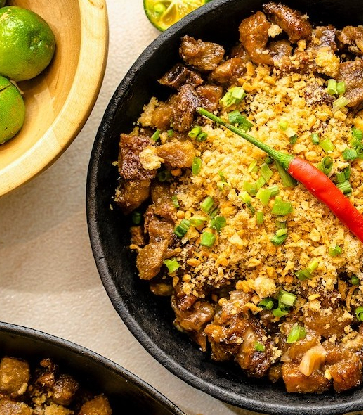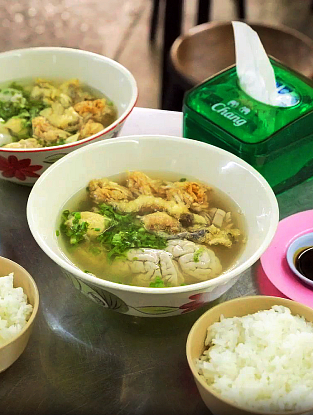The skies are still dark when Panee Chiabchalard arrives at K. Panich. As she always has for over 50 years, she takes her morning coffee, then, around 5 am, she starts the daily ritual of kneading freshly grated coconut flesh to prepare coconut cream and coconut milk for the family shop’s signature sticky rice—a process that takes until about 10 am on a normal day, and well past noon during busier times.
A machine is used for the mixing. Sugar, salt, and other ingredients are weighed on a scale instead of measured by plastic bowls, cups, and eyes. The ingredients are still sourced from the same place as they were nearly a century ago, and the love and care put into the coconut milk and sticky rice remains unchanged.

K. Panich as we know it today was founded in 1927 by Kab and Sarapee Chiabchalard, Panee’s parents-in-law. The family recipes were first passed to Sarapee from Li Khamamporn, an aunt figure who used to look after her when she was younger and who also worked as a cook in the royal palace during the reigns of King Rama V and King Rama VI. “I was working as a teacher in my mid-20s when I was asked to take over the shop,” says Panee. “I initially was not keen, but my mother-in-law said that if I didn’t, it would be a shame that the name we built for ourselves, and the knowledge passed down through the ages, would all go to waste.”
Now 80 years old, Panee is still a fierce believer in time-honoured traditions and the importance of being there for your customers, values that she is passing on to the third-generation owners of K. Panich. “My mother taught my sisters and I about making sticky rice when we were young,” says Anchalee, who is currently a lecturer of medical technology at Chulalongkorn University. “I am also running this business together with my mother, but when I retire in five years at the age of 60, I plan to take full responsibility of this shop.”

Now 80 years old, Panee is still a fierce believer in time-honoured traditions and the importance of being there for your customers, values that she is passing on to the third-generation owners of K. Panich. “My mother taught my sisters and I about making sticky rice when we were young,” says Anchalee, who is currently a lecturer of medical technology at Chulalongkorn University. “I am also running this business together with my mother, but when I retire in five years at the age of 60, I plan to take full responsibility of this shop.”
Panee (L) and Anchalee (R), sitting under the portraits of K. Panich founders Kab and Sarapee Chiabchalard. (© Tina Hsiao/ MICHELIN Guide Thailand)
“She still has a lot to learn,” says Panee of her eldest daughter with a smile, adding that she’s about 70% ready. And there’s a lot to learn, from ensuring the coconut meat from Chumphon is at an optimal ripeness to produce sweet and fragrant coconut cream and milk, to making sure the glutinous rice from Chiang Rai is long, slender, and untainted with normal rice. “Our sticky rice can be kept at room temperature for three days without refrigeration despite not adding any preservatives, because we use the best quality ingredients, and we focus on hygiene in the preparation process,” says Panee. “Our sticky rice may be more expensive than others, but that’s because the ingredients we use are better.”

What to order?
First, second, and even third-generation customers can buy the shop’s famed sticky rice (THB230/kg) and mangoes from independent vendors in front of the shop or buy a ready-to-eat Mango and Sticky Rice set (THB125). Other popular dishes include traditional Sticky Rice with Thai Custard (THB65 per set of six), as well as the sweet-and-savoury Sticky Rice with Sugar Dried-Fish and Sticky Rice with Seasoned Shrimp (THB50).
After mango season ends in June, customers can continue indulging in a variety of traditional Thai desserts, all made in-house using closely guarded family recipes, including Thai-Style Milk Toffee, which takes about five hours to make; Sticky Rice with Banana Filling, Four-Layered Coconut Milk Custard, and Steamed Banana Cake.
Judging by the steady parade of customers that visit Panee’s modest shop every day—some leaving with huge bags of mango and sticky rice, others stopping for a swift curb-side feast—many Thai people share her appreciation for quality ingredients and natural goodness, and her dedication to this sweet family tradition looks set to endure.










%20-%20Aman%20Nai%20Lert.jpg)








